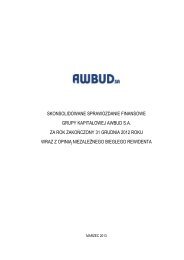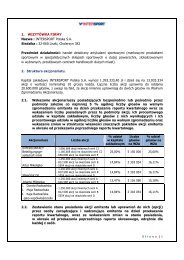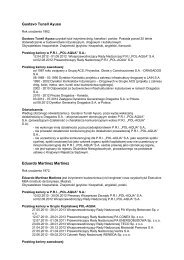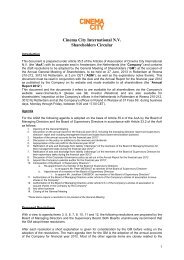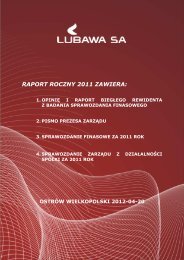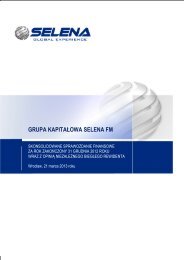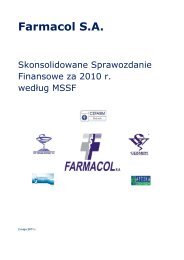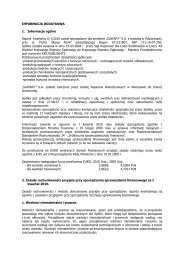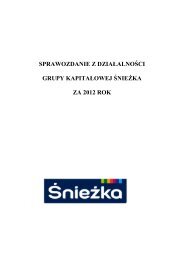DIRECTORS' REPORT ON PGNiG SA'S OPERATIONS ... - Notowania
DIRECTORS' REPORT ON PGNiG SA'S OPERATIONS ... - Notowania
DIRECTORS' REPORT ON PGNiG SA'S OPERATIONS ... - Notowania
Create successful ePaper yourself
Turn your PDF publications into a flip-book with our unique Google optimized e-Paper software.
Directors’ Report on <strong>PGNiG</strong> S.A.’s Operations in 2008<br />
Odolanów Branch, connecting the system for extraction of nitrogen-rich gas to the high-methane gas<br />
transmission network.<br />
Crude Oil Production<br />
In August 2008, <strong>PGNiG</strong> S.A. signed a PLN 1.4bn contract with the consortium of Poland’s PBG S.A.,<br />
Italy’s Technip KTI S.P.A. and Canada’s Thermo Design Engineering Ltd. to carry out the project<br />
“LMG Project – Central facilities, borehole areas, pipelines and other infrastructure”. The<br />
commencement of work is scheduled for 2009.<br />
Development of the Lubiatów-Międzychód-Grotów (LMG) reserve and intensified production from<br />
the Barnówko-Mostno-Buszewo (BMB) reserve are two projects aimed at increasing <strong>PGNiG</strong>’s crude<br />
oil production output. The Company plans that in 2009 the crude oil production will reach more than<br />
500 thousand tonnes. A significant increase in crude oil production is expected in 2013, when the<br />
LMG reserve is developed and placed in operation, and is to amount to approx. 0.9m tonnes annually.<br />
4. Risks Related to Exploration and Production<br />
Resource Discoveries and Estimates<br />
The main risk inherent in exploration activity is the risk of no reserve discovery, i.e. the exploratory<br />
risk. This means that not all the identified potential reserve sites have sufficient deposits of<br />
hydrocarbons meeting the definition of the reserve. Whether or not such deposits exist depends on a<br />
number of geological factors. Furthermore, the actual quantity and quality of the accumulated<br />
hydrocarbons may differ from expected. When the results of successful exploration activity, in the<br />
form of documented new reserves, do not offset the production from the existing deposits,<br />
<strong>PGNiG</strong> S.A. documented producible reserves will decrease pro rata to the current production volumes.<br />
A number of the factors and assumptions adopted when determining the extent of resources and<br />
production projections may turn out erroneous due to flaws in the methods and measurement<br />
equipment used in the geophysical surveys, drilling and production testing. Data on economically<br />
viable producible reserves of crude oil and natural gas is actually estimated and the actual production,<br />
income and expenses relating to a given deposit may significantly differ from the estimates. The<br />
weight of this risk is further increased by the fact that the full business cycle from the commencement<br />
of exploration to the launch of production from a developed field lasts six to eight years, while the<br />
hydrocarbon production cycle lasts from 10 to 40 years. Deposit parameters established in the course<br />
of preparing the relevant documentation are reviewed upon deposit development. Each downgrade of<br />
the extent of the resources or extraction figures may lead to a lower revenue and adversely impact<br />
<strong>PGNiG</strong> S.A.’s financial performance.<br />
Competition<br />
Both on the Polish market and abroad there is a risk of competition from other companies with respect<br />
to acquisition of licences for exploration and prospecting of deposits i.e. implementation of a strategy<br />
providing for acquiring access to own hydrocarbon resources. Certain competitors of <strong>PGNiG</strong> S.A.,<br />
especially those active globally, enjoy strong market positions and have financial resources larger than<br />
those of <strong>PGNiG</strong> S.A. Thus it is probable that such companies would submit their bids in tender offers<br />
and be able to acquire promising licences. Competitors are also able to define, value, offer and<br />
purchase numbers of fields (including the operation thereof and underlying licences) larger than it<br />
would be possible in the case of <strong>PGNiG</strong> S.A., given the Company’s financial and human resources.<br />
This competitive edge of other market players is particularly important on the international market.<br />
However, in view of the growing intensity of the global financial crisis, the risk seems to be<br />
decreasing.<br />
24 of 55



